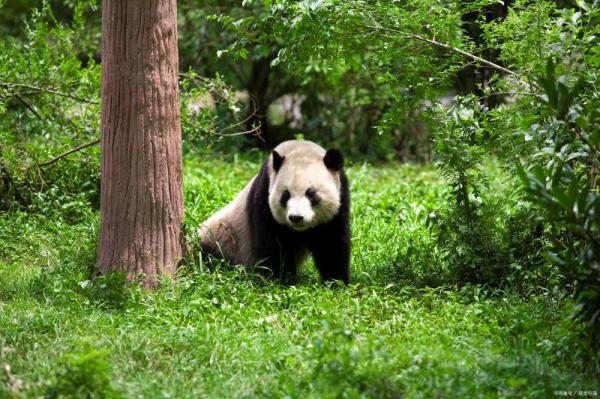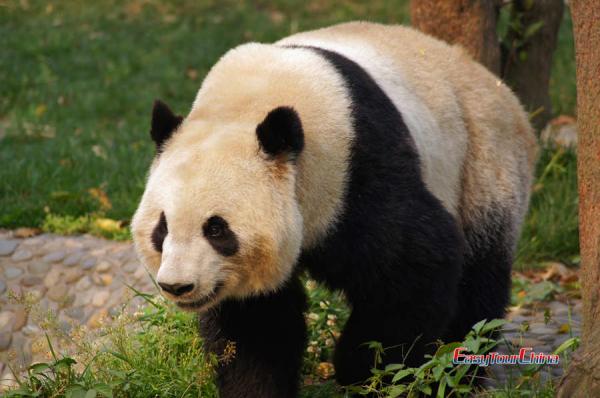Top 10 Surprising & Fun Facts about Giant Pandas
Table of Contents
- 1. What Is the Giant Panda?
- 2. Are Giant Panda Bears Endangered?
- 3. Where Does the Giant Panda Bear Live?
- 4. How Many Giant Pandas Are Left in the World?
- 5. What Do Giant Pandas Eat?
- 6. What Is the Closest Relative to a Giant Panda?
- 7. How Big Is a Giant Panda Bear?
- 8. How Long Can Giant Pandas Live?
- 9. What Sound Does a Giant Panda Make?
- 10. Are Giant Pandas Aggressive?
1. What Is the Giant Panda?
The giant panda is a mammal from the bear family and the genus Ailuropoda. Being endemic to China, giant pandas are considered one of the cutest animals in the world and are known as the "living fossil." Notably, a group of giant pandas is called an embarrassment for their lovely behavior.
The scientific naming of the giant panda begins with the French naturalist Armand David. In 1869, David discovered the giant panda species in Baoxing, Sichuan. Based on the giant panda's morphology, he believed it to be a rare species of bear. He designated the giant panda's scientific name as "Ursus melanoleucus," which is Latin for "black-and-white bear." Later, researchers changed the scientific name of the giant panda to "Ailuropoda melanoleuca," which means "black-and-white panda" in Latin. This scientific name has been used ever since.

2. Are Giant Panda Bears Endangered?
In 1986, the International Union for Conservation of Nature (IUCN) scientifically classified the giant panda as an endangered species for the first time. Why were giant pandas an endangered species? On the one hand, changes in the natural environment, such as climate change and natural disasters, have destroyed the habitats of the giant panda bear. On the other hand, human activities, such as deforestation and modern construction, have also caused damage to their habitats.Good news came in 2016 when the IUCN downgraded the giant panda's threat status from endangered to vulnerable. This fact about giant pandas is exciting, undoubtedly.
Various measures have been taken to protect giant pandas, including establishing nature reserves, implementing conservation projects, and conducting artificial breeding. Currently, the distribution area of giant pandas in China has gradually expanded, and their population number has been increasing year by year.
3. Where Does the Giant Panda Bear Live?
The historic range of the giant panda was once widely distributed across many regions in China, especially in the middle and lower reaches of the Yangtze River basin. Several hundred thousand years have passed; and nowadays, wild giant pandas mainly inhabit some mountainous regions of Sichuan, Shaanxi, and Gansu provinces in China, with altitudes that range from 1,200 meters to 3,500 meters.
Sichuan is the "core hometown" of the giant panda. Famous giant panda reserves such as Wolong Nature Reserve and Baoxing Nature Reserve not only boast superior ecological environments but are also central zones for scientific research and breeding work. The Qinling Mountains in Shaanxi Province are another important habitat for giant pandas. A fun fact about the giant pandas here is that they are slightly smaller in size and have a brownish fur color, which has led some scholars to identify them as a unique "Qinling subspecies."
>> Related reading: How to Become a Panda Volunteer in China
4. How Many Giant Pandas Are Left in the World?
By the end of 2024, there were about 1,900 wild giant pandas left in the world. Additionally, the global population of captive giant pandas has reached 757, with 56 residing abroad. These pandas are collaborating in conservation research efforts with 18 countries and 20 institutions. For instance, Bao Li and Qing Bao are the two giant pandas living in the National Zoo in Washington.
>> Recommended 10 Days China Panda Tour

5. What Do Giant Pandas Eat?
Like other bear species, the giant panda is an omnivorous animal in the process of transitioning from a carnivore to an herbivore. Their primary food is bamboo, which is one of the well-known facts about giant pandas. Generally, they spend approximately 14 hours a day chewing on bamboo, occupying most of their active time. Besides, wild giant pandas will also eat a variety of other foods, such as grass, wild fruits, insects, and bamboo rats. This forms part of the giant panda diet. The giant panda has human-like thumbs that aid in grasping bamboo stalks. It's worth noting that a thick mucosal layer in their stomachs protects them from sharp bamboo fragments. Nevertheless, giant pandas lack the teeth and fiber-digesting bacteria found in other herbivores, which helps in digesting and absorbing plant fiber and nutrients. Therefore, to meet their nutritional needs, giant pandas eat bamboo in substantial amounts, ranging from 15 to 20 kilograms every day.6. What Is the Closest Relative to a Giant Panda?
Like human beings, giant pandas also have relatives, and all of them belong to the Carnivora order, Ursidae family, and Mammalia class. This is one of the fun facts about giant pandas. More specifically, giant pandas have seven relatives, namely polar bears, brown bears, American black bears, sun bears, Asian black bears, spectacled bears, and sloth bears. Among these relatives, giant pandas and spectacled bears are the closest.
Scientists have studied the genes of both and concluded that giant pandas were the first to evolve independently from the common ancestors of ursine animals, followed by spectacled bears as the second. Hence, the relationship between spectacled bears and giant pandas is closer than that with other bear species.
7. How Big Is a Giant Panda Bear?
In terms of weight, wild giant pandas vary between 60 and 73 kilograms, and captive giant pandas tend to be heavier. They usually weigh between 80 and 125 kilograms, with the heaviest individuals reaching an astonishing 180 kilograms. Typically, male individuals are slightly larger than females.
Wondering how tall a giant panda is? The shoulder height of giant pandas is 650 to 750 millimeters, and the hip height is 640 to 650 millimeters; their body length typically ranges from 1200 to 1800 millimeters, which is also one of the amazing facts about giant pandas.
>> Recommended 12 Days Majestic West China Tour with Panda Visit & Yangtze

8. How Long Can Giant Pandas Live?
Typically, wild giant pandas have a lifespan ranging from 14 to 20 years, which constitutes one of the fundamental facts about giant pandas. They encounter tremendous survival pressures due to the tough conditions in their natural habitat. For instance, the instability of bamboo resources often affects their existence. In addition, they often have to confront the threat of giant panda predators, although adult pandas, with their large size and relatively powerful strength, have virtually no natural enemies.
On the other hand, the life expectancy of giant pandas in captivity is between 25 and 30 years, which is longer than that of wild giant pandas. Because in captivity, they have good resources and will be taken better care of.
9. What Sound Does a Giant Panda Make?
The giant panda is a relatively quiet animal and seldom makes sounds in its daily life, but they do so in certain situations and moods. Initially, the sounds of giant panda cubs are relatively monotonous. Nevertheless, as they grow older, their calls become increasingly complex.
When expressing a certain desire or request, like searching for a cub or seeking a mate, the giant panda will make a sound resembling a sheep's "baa." But when frightened, it will produce a warning sound similar to a dog's bark. Also, when attacking, it will generate a "howling" sound. These vocalizations are just one of the fascinating facts of giant pandas.
10. Are Giant Pandas Aggressive?
In general, giant pandas are friendly and will not attack humans proactively. Moreover, wild giant pandas will actively avoid contact with humans. However, when they feel threatened, they will strike back without hesitation, especially female giant pandas. When they are nursing their cubs, they become more aggressive.
In addition, giant pandas have a strong sense of territory, which is one of the remarkable facts of giant pandas. Although giant pandas are not dangerous, they will not hesitate to take countermeasures once strangers or other animals intrude into their territory. For example, a giant panda named Gugu bit a human in response to a stranger entering its habitat. Therefore, when visiting giant panda habitats or interacting with pandas as a panda keeper, you should remain calm and avoid causing discomfort to the pandas.

Best Places to See Giant Pandas
You may have watched movies or animated cartoons about giant pandas, like Kung Fu Panda. If you also want to see giant pandas in person during your Chengdu travel, below are the best places for you.1. Chengdu Research Base of Giant Panda Breeding
Featuring giant panda research, breeding, and ex-situ conservation, this is the most famous and largest panda base in China. It is home to over 200 giant pandas, as well as a special "kindergarten" for cubs. The famous panda Huahua resides here.>> Recommended 3-day Chengdu panda tour with Leshan2. Dujiangyan Panda Base - China Panda Conservation and Research Center
This place provides pandas with a larger activity space. The environment is more natural, making it suitable for tourists who prefer tranquility. Occasionally, you can witness pandas climbing trees and engaging in wild behaviors such as fighting.
>> Recommended 1-day panda volunteer tour to Dujiangyan Panda Base
3. Wolong China Giant Panda Garden – Shenshuping Base
This is the habitat for over 70 giant pandas, including cubs, adult pandas, and those undergoing wildness training programs. It houses many pandas that have returned from abroad, such as Fubao, Xiaoqiji, Yiyi, and others. You can observe panda cubs up close within the park.
>> Recommended 5-day Chengdu panda volunteer tour for family with teenagers

Visit Giant Pandas in China with ETC
With these giant panda facts, you must have learned more about giant pandas. If you want to visit giant pandas, we can tailor make private China panda tours for you according to your preferences. Below are our popular Chengdu tours with giant pandas.